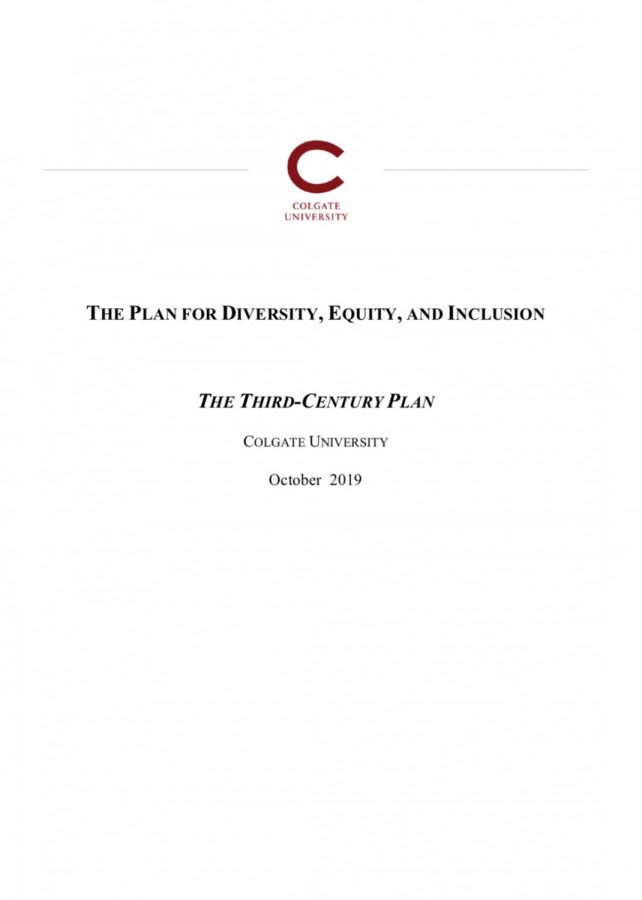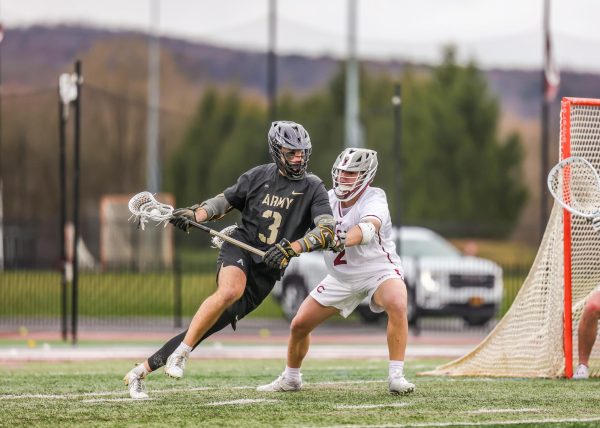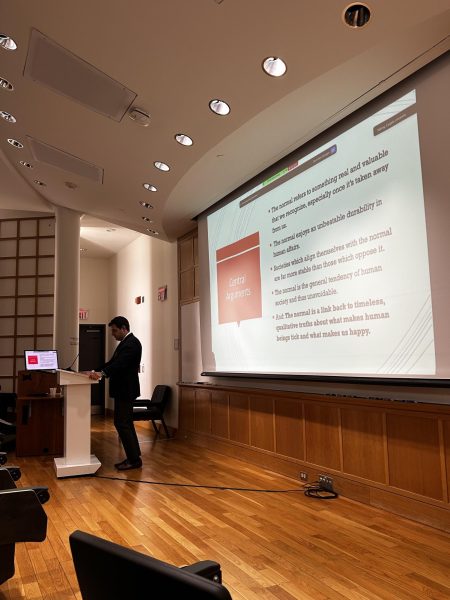Diversity, Equity and Inclusion Plan: An Inside Look
The Diversity, Equity and Inclusion (DEI) plan, released to the Colgate community on Wednesday, October 30 in an email from President Brian Casey and Provost and Dean of the Faculty Tracey Hucks, will create institutional structures to organize and improve University DEI efforts.
The plan is designed to expand on the high-level DEI goals that are included in Colgate’s Third-Century Plan released earlier this year: Foundational DEI Structure, Equity in the Student Experience, Diversification of Faculty and Staff, Retention and Development of Diverse Faculty and Staff, Campus Culture and DEI Responsiveness. While these goals are broadly defined in the Third-Century Plan, the DEI Plan offers the concrete immediate initiatives that will be enacted to make these high-level goals happen.
The document itself is structured as a series of 74 initiatives broken down into the person, group of people or department responsible for the initiative and the target date of its completion. These initiatives are broken into the categories of the six aforementioned high-level goals. The goal of Foundational DEI Structure has by far the most initiatives under its category, which reflects the plan’s focus on creating institutional structures to organize DEI efforts and to incorporate them into every University division.
Though unintended, the plan’s release immediately followed the discovery of a racist message written on a dorm whiteboard in Russell House. Casey said that he and Hucks had previously chosen the release date of October 30, somewhat arbitrarily, in an effort to put a cap on the now years-long discussion about the plan.
Casey and Hucks discussed potentially postponing the plan’s release in the wake of the racist whiteboard incident reported late on October 29. Casey, Senior Advisor to the President and Assistant Dean for Administrative Advising Christopher Wells and Associate Provost for Equity and Diversity Maura Tumulty all agreed the incident made the plan seem reactive when it was meant to be proactive, but postponing the plan any longer would only delay the important discussion to follow.
“The timing of this is not what anyone would have chosen. Part of the reason for wanting to work towards a moment of being able to release a really comprehensive and ambitious plan that covered all aspects of the university was precisely to avoid this kind of dancing posture of always being reactive, and then the very day that for a long time the release had been planned, is the day of the racist slur…This was not a reaction to that incident, this was already coming,” Tumulty, who provided feedback and consultation during the drafting phase of the Plan’s creation, said.
The plan is meant to change the recognized cycle of crisis and reaction that Casey has consistently seen on campus. Wells also acknowledged the reactive pattern that has emerged, resulting in a sporadic and slow pace of change on campus with regards to diversity, equity and inclusion.
“Reports written in response to crises rarely build structural and financial responses, they tend to be this effort to say something rather than to do something. So the whole first part of this report is how do we create structures because, I hate to be the person to say this, but we will have another event sometime soon. By the way, every campus does,” Casey said.
According to Tumulty, the contents of the document are focused on creating a centralized and better organized system of public accountability for Colgate’s DEI efforts. By assigning responsible individuals to each initiative, the plan looks to integrate DEI efforts into the framework of the institution. The plan will also create a centralized DEI structure: the document outlines that a Vice Provost for Equity and Diversity will be hired by July 1, 2020 as the University builds a DEI team with allocated funds. Additionally, every department on campus will contribute to an annual report about the status of DEI efforts on campus called “Colgate’s Annual DEI Report to the Campus,” overseen by Wells and each University Vice President.
“Developing a community expectation of annual accountability could help to combat the historical inconsistency of past DEI efforts at Colgate. Colgate will, therefore, design and implement this report to include contributions from each vice president’s division, and will share it each academic year with the entire campus community,” the plan reads.
The plan also outlines initiatives to specifically increase diversity in University hiring, admissions searches and recruitment. The plan seeks to understand faculty and student retention rates based on diversity, equity and inclusion, in order to kickstart enhanced training options for students, faculty and staff leaders. Many of these initiatives include the allocation of funds to training programs, staffing, student groups and particular alumni groups, such as Colgate’s Africana, Latin, Asian, and Native American (ALANA) Cultural Center’s Mosaic initiative. This initiative organizes and sponsors events to connect multicultural alumni with each other and students.
Retroactively, the document prescribes an external review of the University’s Equity Grievance Policy, further internal analysis of the inclusivity of Colgate’s policies, along with the review of many other departments’ policies and practices.
The document also addresses campus culture with analysis and effort to expand social spaces available to all student groups, being that fraternity houses on Broad Street represent only a minority of the student body. Additionally, the document affirms continued University support for online counseling sessions with counselors of color when the needs of students on campus cannot be met. The DEI section on student experience also addresses the needs of student-athletes of color, support for groups that support students affected by federal immigration policy, students with educational and other disabilities and families with limitations.
Casey explained that the goal of improving the student experience and changing campus culture will likely be a longer one. He pointed to the social spaces initiative as the most important in the document for changing campus culture.
“In matters of student life, you don’t want to be changing every eight to nine months… I think in important structural issues the university should take the time it needs,” Casey said. “On the student social question? It might be a long conversation. It might be one of the most important conversations I’m involved in.”
Given the Plan’s focus on short-term action, Casey acknowledged that the document is not particularly satisfying. Wells explained why this might be the case: in rhetoric, the document is not meant to be “inspiring.” He emphasized it was never intended to be a reactive plan, but rather a proactive creation of institutional structures.
“As I’m compelled to say a lot, that’s necessary but not sufficient,” Wells said. “One of the ways I could imagine the ongoing plan developing is to become more inspirational as we make progress; as the boulder begins to move, it becomes easier and easier to think that we could engender excitement. This plan is not designed to engender excitement ahead of progress or achievements. It’s really just a blueprint for beginning to make some movement.”
At the beginning of the 2017-2018 academic year, Casey and Hucks initiated the creation of the Diversity Equity and Inclusion Task Force, which eventually broke into five sub-committees. Around 75 faculty, students and staff then spent the academic year meeting in focus groups to discuss the status of and potential improvements to diversity, equity and inclusion on campus.
This process, Wells said, was largely one of brainstorming to reach consensus on the top priorities of the campus.
“Colgate is large for a liberal arts college; building a broad grassroots consensus about what’s the most pressing thing to address or how to address it is actually really hard here,” Wells said. “We only had 75 people or so which is a nice, sort of, robust group but that’s a tiny fraction, obviously, of the overall population. Even with just 75 folks broken into smaller working groups, it’s a challenge to agree on what’s the top priority.”
Eventually, the working groups proposed their recommendations to Casey and Hucks in the summer of 2018, resulting in the first draft of the report, at which point Casey and Hucks began a long drafting period, involving faculty and staff on campus.
In addition to this work done by the DEI Task Force, the document interacts with and includes previous documents, studies and efforts conducted by and for the University, particularly the third-party survey of Colgate’s Diversity, Equity and Inclusion of 2017 and the University’s 2005 21-point plan for Diversity, Equity and Inclusion.
Casey said that the plan as it is released is not complete or perfect; Wells, Casey and Tumulty all emphasized that the plan’s release is not the last step of DEI work on campus. Rather, the release of the plan ushers it into its next phase of development, larger community involvement.
“The worst-case scenario from my point of view is not that folks would have harsh critiques of the plan, [it] is that they wouldn’t engage,” Wells said. “I really do think the potential for real creativity and evolution is forward-looking more than backward.”
Senior and participant in the DEI Task Force Anthony Wright said that moving forward, broader student involvement will be really important in building this document. Since the Task Force was entirely volunteer-based, the participation ended up not being entirely diverse, meaning that reaching out to different student groups like Greek organizations or the College Democrats and Republicans will be really important moving forward.
The first public forums for community engagement with the document are scheduled for Friday, November 15 and Tuesday, November 19. Additionally, students are encouraged to react to the document using the email account DEI@colgate.edu.
“My hope is that people are going to read the whole thing, and think about it, and think about how their reactions to it are affected by aspects of their own identity, their racial identity… but also their place on campus and then have these conversations and where people see places where they would like to push the institution further. One of the things I’m very happy about with the plan is that it gives people a roadmap for how to do that,” Tumulty said.
Emily Rahhal is a senior from Los Angeles, California double concentrating in Middle Eastern and Islamic Studies and Religion. She has previously worked...







